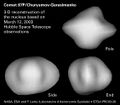Astronomy:2014 AF5
| Discovery[1] | |
|---|---|
| Discovered by | Catalina Sky Survey (703) |
| Discovery date | 2 January 2014 |
| Designations | |
| 2014 AF5 | |
| Minor planet category | |
| Orbital characteristics[2] | |
| Epoch 13 January 2016 (JD 2457400.5) | |
| Uncertainty parameter 7 | |
| |{{{apsis}}}|helion}} | 2.3810 astronomical unit|AU (356.19 Gm) (Q) |
| |{{{apsis}}}|helion}} | 0.75353 AU (112.726 Gm) (q) |
| 1.5672 AU (234.45 Gm) (a) | |
| Eccentricity | 0.51920 (e) |
| Orbital period | 1.96 yr (716.64 d) |
| Mean anomaly | 35.862° (M) |
| Mean motion | 0° 30m 8.424s / day (n) |
| Inclination | 6.4141° (i) |
| Longitude of ascending node | 100.66° (Ω) |
| 288.71° (ω) | |
| Earth MOID | 0.000570632 AU (85,365.3 km) |
| Jupiter MOID | 3.08041 AU (460.823 Gm) |
| Physical characteristics | |
| Dimensions |
|
| Mass | 5×105 kg (assumed) |
| Absolute magnitude (H) | 28.8[2] |
2014 AF5 (also written 2014 AF5) is an Apollo near-Earth asteroid roughly 5–10 meters in diameter that passed less than 1 lunar distance from Earth on 1 January 2014.[3]
Description
From mid November 2013 until 1 January 2014 15:00 UT the small dim asteroid had an elongation less than 45 degrees from the Sun with an undetectable apparent magnitude of around 30.[4] While less than 18 degrees from the Sun any dim asteroid can be lost in astronomical twilight. On 1 January 2014 10:00 UT the asteroid passed 0.00062 astronomical unit|AU (93,000 km; 58,000 mi) from the Moon and at 16:13 UT passed 0.00064 AU (96,000 km; 59,000 mi) from Earth.[3] The asteroid was then discovered on 2 January 2014 by the Catalina Sky Survey at an apparent magnitude of 18.9 using a 0.68-meter (27 in) Schmidt–Cassegrain telescope.[1] By 3 January 2014 the asteroid was becoming dimmer than apparent magnitude 20.[4]
See also
- List of asteroid close approaches to Earth in 2014
References
- ↑ 1.0 1.1 "MPEC 2014-A19 : 2014 AF5". IAU Minor Planet Center. 2014-01-04. Archived from the original on 2014-02-01. https://web.archive.org/web/20140201230708/http://www.minorplanetcenter.net/mpec/K14/K14A19.html. Retrieved 2014-01-25. (K14A05F)
- ↑ 2.0 2.1 2.2 "JPL Small-Body Database Browser: (2014 AF5)". Jet Propulsion Laboratory. http://ssd.jpl.nasa.gov/sbdb.cgi?sstr=2014AF5. Retrieved 4 April 2016.
- ↑ 3.0 3.1 "JPL Close-Approach Data: (2014 AF5)". http://ssd.jpl.nasa.gov/sbdb.cgi?sstr=2014AF5;cad=1#cad. Retrieved 2014-01-25.
- ↑ 4.0 4.1 "2014AF5 Ephemerides for 15 November 2013 through 10 January 2014". NEODyS (Near Earth Objects – Dynamic Site). Archived from the original on 2014-02-03. https://web.archive.org/web/20140203104105/http://newton.dm.unipi.it/neodys/index.php?pc=1.1.3.1&n=2014AF5&oc=500&y0=2013&m0=11&d0=15&h0=0&mi0=0&y1=2014&m1=1&d1=10&h1=0&mi1=0&ti=1.0&tiu=days. Retrieved 2014-01-25.
External links
- 2014 AF5 at NeoDyS-2, Near Earth Objects—Dynamic Site
- Ephemeris · Obs prediction · Orbital info · MOID · Proper elements · Obs info · Close · Physical info · NEOCC
- 2014 AF5 at ESA–space situational awareness
- 2014 AF5 at the JPL Small-Body Database
 |




